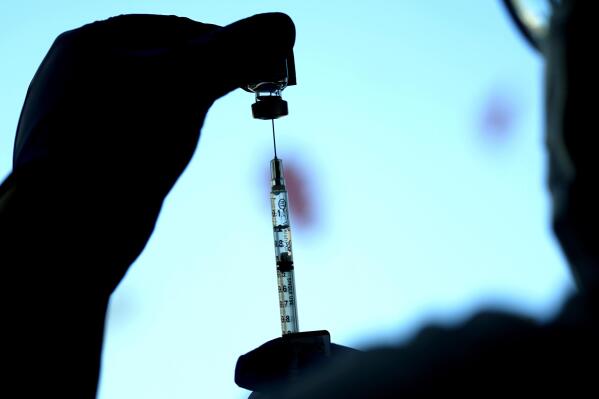Social media posts misconstrue the efficacy of vaccines for flu, measles, mumps and rubella

FILE - A flu vaccine is readied at the L.A. Care and Blue Shield of California Promise Health Plans’ Community Resource Center where they were offering members and the public free flu and COVID-19 vaccines Friday, Oct. 28, 2022, in Lynwood, Calif. The Associated Press on Thursday, Sept. 7, 2023 reported on a misleading meme being shared on social media suggesting the flu, measles, mumps and rubella still exist even though inoculations against those diseases have been around for decades. (AP Photo/Mark J. Terrill, File)
CLAIM: Vaccines for the flu, measles, mumps and rubella were developed decades ago, yet the diseases haven’t been eradicated, proving that the immunizations don’t work.
AP’S ASSESSMENT: False. Cases of measles and rubella have been virtually eliminated in the U.S., thanks to vaccines, according to public health agencies and experts. Flu and mumps vaccines, meanwhile, have helped drastically reduce the incidence of serious illness and death from those diseases. Other once-deadly illnesses, such as smallpox and polio, have also all but been eliminated in the country by vaccinations.
THE FACTS: Social media users are casting doubt on the COVID-19 vaccine by sharing a misleading meme that suggests the flu, measles, mumps and rubella still exist even though inoculations against those diseases have been around for decades.
“The flu vaccine was invented 78 years ago. The MMR vaccine was invented 60 years ago,” the meme reads. “I might not be a smart man, but I don’t think those vaccines are working.”
“How many years will we continue to pretend the COVID [vaccine] works, too?” wrote an Instagram user who shared the meme, using an image of a syringe instead of the word ‘vaccine.’
But the notion that vaccines haven’t had an effect on the four diseases doesn’t hold up.
For one thing, measles and rubella have been considered eliminated in the U.S. for almost two decades now because most people in the country are vaccinated against the illnesses, according to the Centers for Disease Control and Prevention.
But while the diseases are no longer considered endemic, or constantly present, in the country, they remain problematic elsewhere. That means outbreaks can -- and have -- occurred in recent years, particularly among unvaccinated populations.
Mumps hasn’t been as thoroughly eliminated in the country as those two diseases because the vaccine’s protection wanes over time and isn’t lifetime, as it is with measles and rubella, says William Schaffner, a spokesperson for the National Foundation for Infectious Diseases and an infectious disease professor at Vanderbilt University in Nashville, Tennessee.
But mumps cases have dropped markedly since the country rolled out vaccines, from more than 150,000 cases a year in 1968 to about 320 last year, according to the CDC.
The flu has been more challenging for vaccine developers, because the virus constantly mutates and there are multiple strains of it circulating during any given year, he said. But that doesn’t mean the shot is ineffective.
“So what we have is a vaccine that can mitigate the worst aspects of influenza, but cannot eliminate the infection completely,” Schaffner explained in a phone interview. “There is a great deal of scientific research trying to develop a ‘universal influenza vaccine,’ but we’re not there yet.”
The widely shared meme plays on a common misconception that for vaccines to be effective, they must fully eradicate a disease, says Nicholas Pullen, a biology professor at the University of Northern Colorado.
“This is a nice goal, but it is just not true or likely in most infectious disease situations,” he wrote in an email.
Fundamentally, vaccinations are meant to reduce the likelihood of someone getting the disease and lessen its severity and prevent death if contracted, Pullen said.
Sabrina Assoumou, an infectious diseases physician at Boston Medical Center, argued that research has demonstrated that the flu vaccine is effective in both regards.
During the 2019-2020 flu season, which was the last one before the COVID-19 pandemic, vaccines prevented an estimated 7.5 million influenza illnesses, 3.7 million influenza-associated medical visits, 105,000 influenza-associated hospitalizations and 6,300 influenza-associated deaths, she said, citing CDC data.
Flu vaccination has also been shown to reduce severity of illness, Assoumou said, citing a 2021 study in the journal Vaccine, which showed that vaccinated flu patients had a 26% lower risk of intensive care unit admission and a 31% lower risk of death from flu compared with those who were unvaccinated.
What’s more, by narrowly focusing on the flu and MMR shots, the social media posts are conveniently ignoring the role vaccines played in virtually eliminating in the U.S. two other once deadly illnesses: smallpox and polio, said Paul Offit, director of the Vaccine Education Center at Children’s Hospital of Philadelphia.
“In short, no it is not a fair argument,” said Margaret Harris, a spokesperson for the World Health Organization. “Vaccines work very well, but they only work if they are in arms, not on shelves.”
___
This is part of AP’s effort to address widely shared misinformation, including work with outside companies and organizations to add factual context to misleading content that is circulating online. Learn more about fact-checking at AP.




